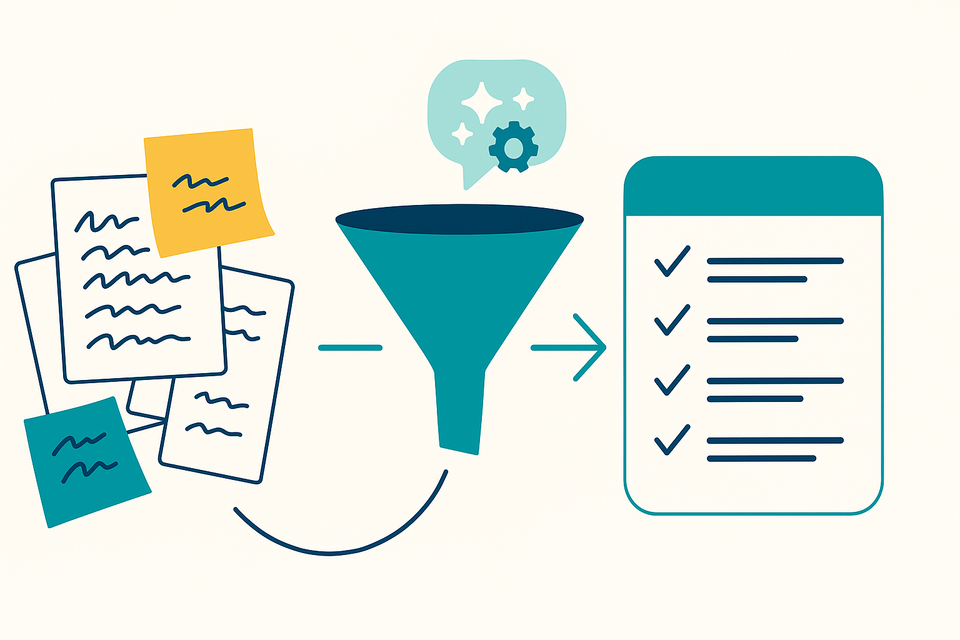Using AI to Give Better Feedback: A Practical Guide

Why is Giving Feedback So Hard?
Ever struggled to find the right words when giving feedback? Felt overwhelmed by character limits or strict formatting requirements? You're not alone. Giving feedback is crucial but can be tricky. It's easy to be too vague, too harsh, or simply run out of time to craft thoughtful responses. For many organizations, providing feedback feels like a compliance exercise—just a box to check—and often isn't as impactful as it should be.
But it doesn't have to be this way! AI can help you give more meaningful and personalized feedback, even with constraints. This post explores how AI can help you express your thoughts clearly, adhere to company guidelines, and ultimately provide better feedback.
Important Note: This post doesn't suggest using AI to generate your feedback. The heart of the feedback must come from you. AI simply helps you structure and refine your thoughts to align with your organization's requirements, feedback framework, and character limitations.
Why is Giving Good Feedback Important?
Before we dive into how AI can help, let's discuss why giving good feedback is essential in the first place.
- Impact on Individuals: Effective feedback fuels employee growth, boosts confidence, and increases job satisfaction. It helps individuals understand their strengths and areas for development.
- Benefits for Teams: Constructive feedback fosters a culture of open communication, improves collaboration, and drives team performance.
- Organizational Success: Organizations with strong feedback mechanisms see increased productivity, innovation, and employee retention. A company's feedback system often reveals what it truly values in its employees.
- Exemplifies Your Leadership Skills: Giving and receiving feedback are crucial leadership skills. By providing thoughtful feedback, you demonstrate your commitment to your team's growth and development.
Remember - This is Your Feedback, Not the AI's
Okay, so how can AI help? As mentioned earlier, it won't give the feedback for you. That's a cop-out. No matter how busy you are, always make time to give your team timely and meaningful feedback. Here's how to get started before involving AI:
- Review Your Organization's Feedback System: Familiarize yourself with the specific questions and format.
- Capture Your Thoughts: Open a document or use a voice memo to answer the feedback questions honestly and completely.
- Don't Hold Back: Express your thoughts freely, without worrying about structure, character limits, or tone. The goal is to capture your authentic feedback; the AI will help make it presentable later.
How AI Can Help
Now for the main event! Here's how AI can assist you in giving better feedback:
- Overcoming Writer's Block: AI can help you "brain dump" your thoughts and overcome the initial hurdle of structuring your feedback. If you're stuck, use an AI chat tool to brainstorm ideas.
- Efficiency and Time-Saving: Automate formatting, structure feedback according to company templates, and even get suggestions for improved tone and language. This is especially helpful when providing feedback to multiple people.
- Objectivity and Balance: AI can help identify potential biases in your feedback and ensure a fair and balanced assessment.
Personalization at Scale: AI can help tailor feedback to individual needs while ensuring consistency and fairness.
For example, you might prompt the AI: "Please take my feedback about [employee name] and make it professional, use active voice, and highlight their strengths and contributions to the project. For their development points, highlight the effort they've made and suggest they continue while starting to look for opportunities to delegate."
Practical Steps to Using AI for Feedback
Here's a general workflow for using AI to refine your feedback:
- Choosing the Right AI Tool: ChatGPT, Google Gemini, and Claude are all excellent options for generating feedback. Experiment to see which you prefer.
- Optimizing Input: Provide clear prompts, context, and desired outcomes to guide the AI. Explain the purpose of the feedback, the individual's role, and any specific guidelines.
Refining and Editing: Always review and edit AI-generated feedback to ensure accuracy, maintain a personal touch, and align with your voice.
Pro Tip: If your organization allows it, upload relevant documents like feedback frameworks to the AI tool for even more tailored results.
Example Workflow:
- Brainstorm: Use AI to freely jot down your thoughts and observations about the individual's performance.
- Structure: Input your company's feedback template or guidelines and let the AI format your thoughts accordingly.
- Refine: Review the AI's output, personalize the language, and add specific examples to support your points.
- Deliver: Confidently deliver your feedback, knowing it's well-structured, comprehensive, and tailored to the recipient.
Addressing Potential Concerns
Ethical Considerations: Avoid over-reliance on AI; maintain human oversight to ensure feedback is appropriate and ethical.
Example of Inappropriate AI Use: "Please give me 5 strengths for Sally for her performance review."
Why it's wrong: You're using AI to relieve yourself of the responsibility of providing feedback. The AI tool has no insight as to who you are, who Sally is, what their contributions to the project was, how they excelled, what they should improve.
Example of Appropriate AI Use: "I'm writing a performance review for Sally for her contributions to Project Gemini. The performance review asks that I provide her strengths and contributions to the project and also some development points. Please see below for my feedback for Sally and create a response less than 600 characters summarizing her strengths and contributions to the project and another response less than 600 characters showing her development points. Use active voice. Sally is an associate who is expected to get promoted to senior associate, use verbs and language that reflects that staff level based on the feedback framework I provided that show she's ready for the next level. [Insert your raw feedback here]"
Why it's better:
- It uses your feedback as the foundation.
- AI helps with summarizing, organizing, and structuring your thoughts.
- It considers Sally's current role and career progression goals.
Maintaining Authenticity: Ensure your feedback reflects your genuine assessment and avoids sounding robotic or impersonal. Review and edit the AI's output to ensure it aligns with your voice.
Data Privacy and Security: Choose AI tools that prioritize data privacy and comply with relevant regulations. Always follow your company's data security policies.
Conclusion
AI can be a powerful tool for enhancing the feedback process, making it more efficient, consistent, and personalized. However, it all starts with you and your feedback.
Experiment with AI tools and discover how they can help you give better feedback. Share your experiences and best practices!

